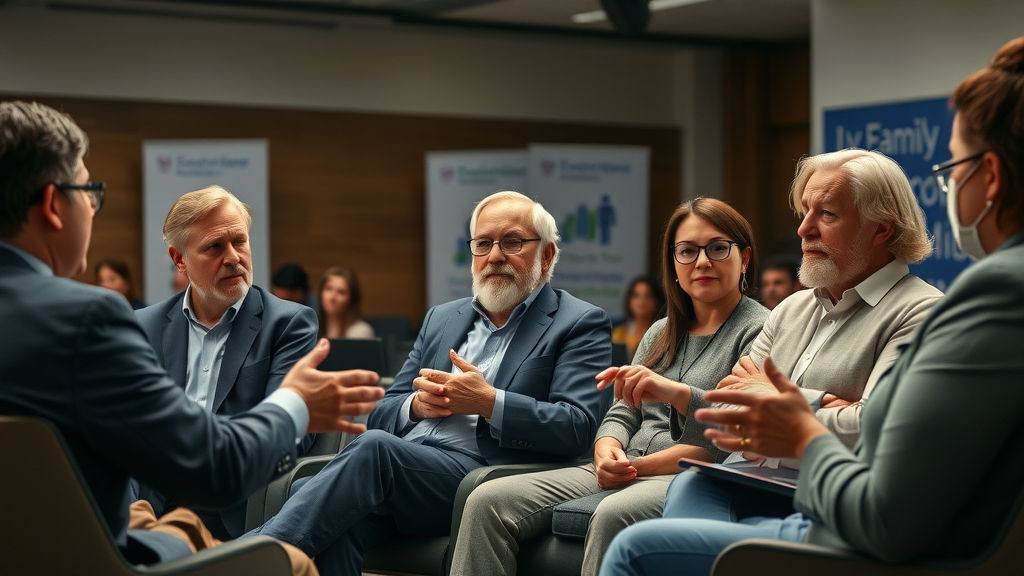Hook: Did you know that nearly 60% of families report that traditional financial services do not address their unique needs? In today’s complex economic reality, the traditional "one-size-fits-all" approach to family financial support is no longer viable. To truly champion the plight of parents and the experiences of parents , our systems need to evolve. This article unpacks the essentiality of meeting families where they are financially , explores systemic gaps, and provides actionable insights for leaders, advocates, and policy makers who are committed to better understanding— and better serving—modern households. If you’re ready for an enlightening and stimulating read that may shift your perspective on financial empowerment, read on.
"Nearly 60% of families report that traditional financial services do not address their unique needs." -- National Family Finance Survey (2023)

Why Meeting Families Where They Are Is Essential in Today’s Economic Climate
The economic climate facing modern families is marked by rapid change, uncertainty, and complexity that were rarely visible in previous generations. From two-income households juggling gig economy jobs to single parents navigating childcare and budgets, family dynamics demand a more nuanced approach. The old paradigm—standard loans, rigid eligibility, and impersonal services—leaves families of all types behind. By meeting families where they are , financial services and community leaders recognize the diversity of modern needs. For example, families of color who have children with disabilities experience layered financial challenges often overlooked by standardized support systems. Similarly, multigenerational households may require unique solutions that traditional models cannot provide. This adaptive, inclusive philosophy is essential for supporting a vision of parental efficacy, equity, and stability in today’s society.
-
Overview of changing family financial dynamics
-
Importance of personalized financial engagement
-
Examples of families left behind by conventional systems

What Traditional Approaches Miss: The Gaps in Not Meeting Families Where They Are
Existing financial support structures, often modeled on city university case studies and institutional research, typically fail to acknowledge the intricate tapestry comprising the complexity of the plight of parents across demographics. Families with non-traditional or fluctuating sources of income, such as those participating in the gig economy or supporting a child with a disability , find themselves shut out of rigid support programs.
The graduate school of education at several universities has illuminated how parents of color experience additional layers of exclusion within these systems—either due to implicit bias, lack of language accommodations, or failure to address cultural financial norms. As a result, parent advocates highlight the need to move beyond a “check-the-box" mentality, advocating for personalized outreach and specialized resources that account for both geographic and cultural factors.
Missed Opportunities: Addressing Diverse Financial Realities
Meeting families where they are requires understanding the spectrum of lived realities—especially those often overlooked by traditional services. Two-income households may appear financially stable on paper, but fluctuating income streams introduce volatility that standard loan programs don’t accommodate. Consider also the challenges faced by single-parent families—where access to support is not just about eligibility, but also about time, flexibility, and localized opportunities. The interplay of geographical and cultural factors often means that families in rural settings or minority communities cannot easily access support available in urban hubs or tailored to dominant majority cultures.
-
Two-income households with fluctuating income streams
-
Single-parent challenges in accessing support
-
The impact of geographical and cultural factors

Innovative Solutions: How Can We Truly Meet Families Where They Are?
"To empower families, we must listen—truly listen—to where they are starting from and what they most need."
Real progress comes from leaving outdated frameworks behind and listening to parental advocacy groups and grassroots community leaders. Community-based initiatives have emerged as powerful models, designing interventions that reflect actual family needs. Local partnerships with financial educators, education advocacy programs, and culturally responsive aid providers set new benchmarks for what’s possible. Serving as “frontline advocates,” local organizations help identify gaps that a university of new york or distinguished professor emeritus research project might overlook—ensuring household voices drive genuine, impactful change rather than being reduced to statistics.
Community-Based Initiatives Setting New Standards
The most successful community models purposefully center the experiences of families, offering tailored grants, flexible counseling, and context-aware support. For instance, organizations have started direct aid programs for parents of color who have children with disabilities—acknowledging intersectional challenges and removing bureaucratic barriers. These innovative initiatives foster belonging and empowerment, equipping communities to challenge systemic inequities head-on while positioning children to thrive. This is advocacy in action, not only addressing immediate needs but also building long-term financial resilience.
-
Local partnerships with financial educators
-
Grants and direct aid tailored to specific households

|
|
|
Comparing Traditional vs. Personalized Family Support |
|
Feature |
Traditional Model |
Meeting Families Where They Are |
|---|---|---|
|
Communication |
One-Size-Fits-All |
Custom-Tailored |
|
Outcome |
Generalized |
Maximized for Each Case |
|
Example |
Standard Loans |
Flexible Grants/Counseling |
Practical Guidance for Leaders: Steps Toward Meeting Families Where They Are
Leaders and policymakers must move beyond theory and into practice. Here are essential steps to reposition support structures for today’s families:
-
Conduct real-world needs assessments
-
Partner with local organizations
-
Adjust eligibility criteria for support
-
Provide culturally responsive financial education
-
Continuously measure satisfaction and outcomes
Implementing these steps requires a concerted, ongoing commitment to understanding the complexity of the modern parental landscape. Leaders in government, nonprofit, and private sectors— from the city university lecture hall to the bustling community center—can champion lasting, systemic change by actively engaging with family advocates and listening to those purposefully vying for inclusion.

Addressing the Critics: Is Meeting Families Where They Are Sustainable?
"The challenge isn’t whether we can afford to meet families where they are, but whether we can afford not to."
Critics often argue that personalized family support models are expensive or unsustainable long-term. However, the evidence increasingly shows that targeted, responsive financial support delivers better outcomes for families and the broader community. By maximizing each household’s potential and preventing crises before they escalate, these models actually reduce systemic costs—fewer emergencies, reduced dependency, and improved public health. Investing upfront in community resilience and empowerment is not only the right thing—it’s the pragmatic, cost-effective option for policymakers intent on positive change.

People Also Ask
How can organizations identify where families are financially?
Organizations can uncover authentic family needs by conducting confidential community surveys and organizing focus groups or listening sessions. These approaches allow voices from all walks of life to be heard, especially those who might otherwise be overlooked or marginalized—such as parents of color or households supporting children with disabilities. True insight arises from ongoing, two-way conversations rather than static data.
-
By conducting confidential community surveys
-
By hosting focus groups and listening sessions

What are some examples of meeting families where they are in practice?
Practical applications include offering sliding-scale payment options at childcare centers, ensuring that financial burdens don’t exclude any families. Another effective strategy is providing non-traditional hours for financial counseling, allowing working parents—such as those attending graduate school or handling multiple jobs—to access crucial support. Adaptability and accessibility are central to turning philosophy into action.
-
Offering sliding-scale payment options at childcare centers
-
Implementing non-traditional hours for financial counseling sessions
Why do one-size-fits-all solutions often fail families?
Every family brings unique backgrounds, needs, and experiences—particularly those from underrepresented groups attending schools like rutgers university or supporting children with disabilities. One-size-fits-all models simply cannot address the financial spectrum that real-life families occupy, ultimately resulting in unmet needs, frustration, and perpetuated disparities. When support fails to account for diversity, families are forced to make difficult trade-offs or are left to slip through the cracks entirely.
-
Families have a spectrum of financial circumstances and needs, making blanket solutions inadequate

FAQs
-
What does 'meeting families where they are' really mean in financial contexts? It means designing support based on a household’s starting point, not arbitrary average metrics. This could involve flexible grants, custom counseling, or policy initiatives that reflect both parental advocacy and the specific needs of distinct groups—like parents of color who have children with disabilities .
-
How can policy makers make a shift towards personalized support structures? Policy makers can partner with local schools, advocacy groups, and parent advocates, engaging directly with communities to reform eligibility, funding, and communication strategies. Ongoing dialogue and feedback are essential in these efforts.
-
Are there extra costs involved in tailored family support? While there may be initial investment, research suggests that customized support reduces long-term systemic expenses—by decreasing emergencies, dependency, and stress on families—resulting in higher satisfaction and community resilience.

Key Considerations and Takeaways for Embracing Meeting Families Where They Are
-
Personalization is the future of financial services
-
Listening is foundational
-
Evaluating outcomes matters more than checking boxes
-
The long-term impact on community resilience outweighs initial investments

If We Are Serious About Change, Let’s Start Meeting Families Where They Are
"Change begins the moment we stop assuming, and start asking, where families are financially."
If we truly intend to challenge inequity—if we wish to create a world where every family feels seen, heard, and empowered—our financial systems must evolve. This is a call for graduate school of education alumni, parent advocates, and policy innovators: Initiate dialogue, assess your reach, and commit to meeting families where they are . Ready to act? Connect today: James@JamesBroadnax.com
 Add Row
Add Row  Add
Add 




 Add Row
Add Row 


 Add
Add
Write A Comment